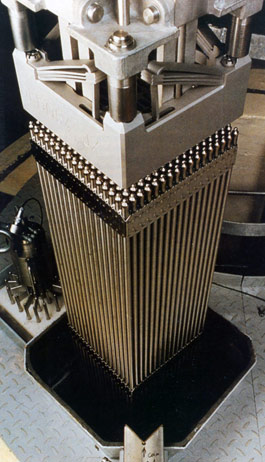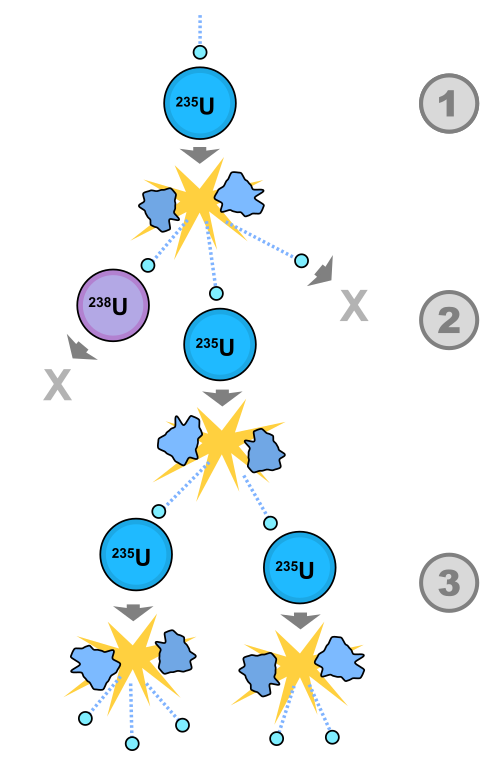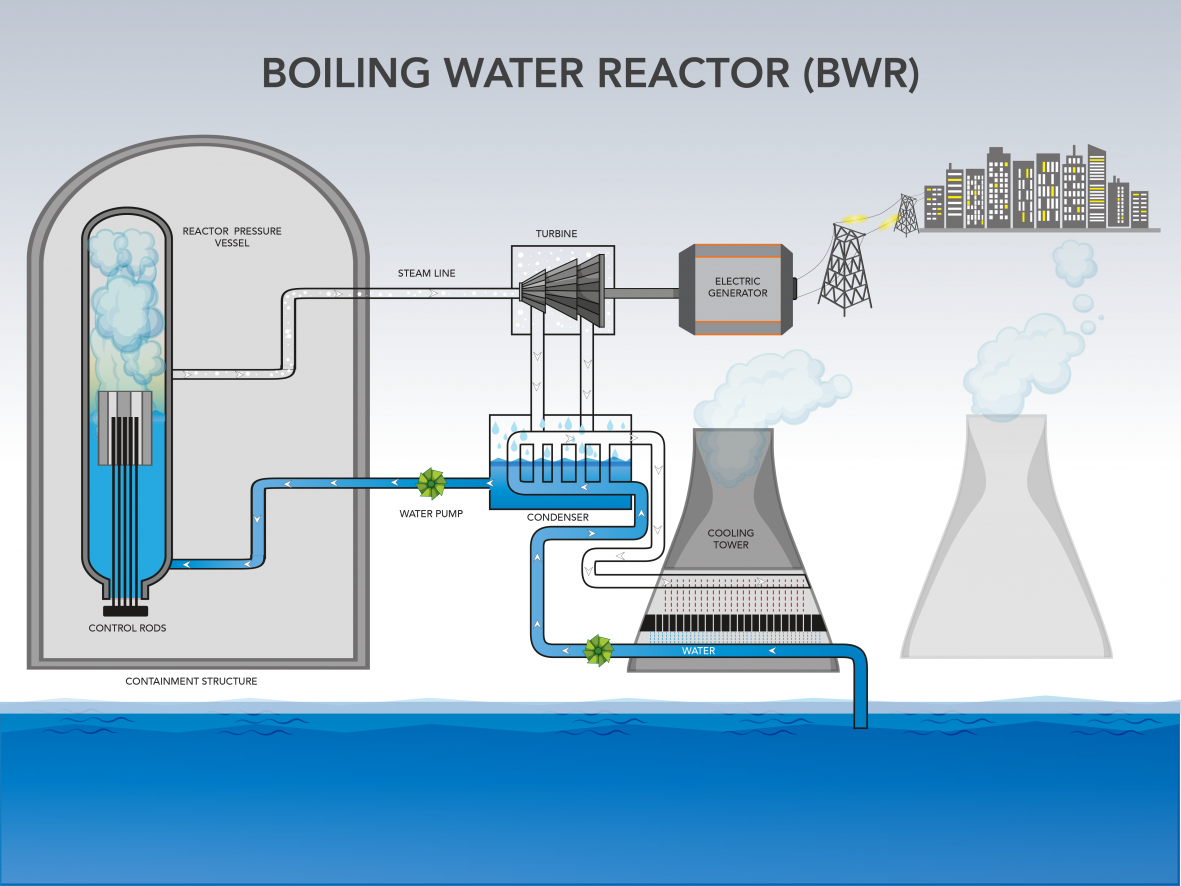17.2: Generating Electricity with Nuclear Energy
- Page ID
- 34985
\( \newcommand{\vecs}[1]{\overset { \scriptstyle \rightharpoonup} {\mathbf{#1}} } \)
\( \newcommand{\vecd}[1]{\overset{-\!-\!\rightharpoonup}{\vphantom{a}\smash {#1}}} \)
\( \newcommand{\id}{\mathrm{id}}\) \( \newcommand{\Span}{\mathrm{span}}\)
( \newcommand{\kernel}{\mathrm{null}\,}\) \( \newcommand{\range}{\mathrm{range}\,}\)
\( \newcommand{\RealPart}{\mathrm{Re}}\) \( \newcommand{\ImaginaryPart}{\mathrm{Im}}\)
\( \newcommand{\Argument}{\mathrm{Arg}}\) \( \newcommand{\norm}[1]{\| #1 \|}\)
\( \newcommand{\inner}[2]{\langle #1, #2 \rangle}\)
\( \newcommand{\Span}{\mathrm{span}}\)
\( \newcommand{\id}{\mathrm{id}}\)
\( \newcommand{\Span}{\mathrm{span}}\)
\( \newcommand{\kernel}{\mathrm{null}\,}\)
\( \newcommand{\range}{\mathrm{range}\,}\)
\( \newcommand{\RealPart}{\mathrm{Re}}\)
\( \newcommand{\ImaginaryPart}{\mathrm{Im}}\)
\( \newcommand{\Argument}{\mathrm{Arg}}\)
\( \newcommand{\norm}[1]{\| #1 \|}\)
\( \newcommand{\inner}[2]{\langle #1, #2 \rangle}\)
\( \newcommand{\Span}{\mathrm{span}}\) \( \newcommand{\AA}{\unicode[.8,0]{x212B}}\)
\( \newcommand{\vectorA}[1]{\vec{#1}} % arrow\)
\( \newcommand{\vectorAt}[1]{\vec{\text{#1}}} % arrow\)
\( \newcommand{\vectorB}[1]{\overset { \scriptstyle \rightharpoonup} {\mathbf{#1}} } \)
\( \newcommand{\vectorC}[1]{\textbf{#1}} \)
\( \newcommand{\vectorD}[1]{\overrightarrow{#1}} \)
\( \newcommand{\vectorDt}[1]{\overrightarrow{\text{#1}}} \)
\( \newcommand{\vectE}[1]{\overset{-\!-\!\rightharpoonup}{\vphantom{a}\smash{\mathbf {#1}}}} \)
\( \newcommand{\vecs}[1]{\overset { \scriptstyle \rightharpoonup} {\mathbf{#1}} } \)
\( \newcommand{\vecd}[1]{\overset{-\!-\!\rightharpoonup}{\vphantom{a}\smash {#1}}} \)
\(\newcommand{\avec}{\mathbf a}\) \(\newcommand{\bvec}{\mathbf b}\) \(\newcommand{\cvec}{\mathbf c}\) \(\newcommand{\dvec}{\mathbf d}\) \(\newcommand{\dtil}{\widetilde{\mathbf d}}\) \(\newcommand{\evec}{\mathbf e}\) \(\newcommand{\fvec}{\mathbf f}\) \(\newcommand{\nvec}{\mathbf n}\) \(\newcommand{\pvec}{\mathbf p}\) \(\newcommand{\qvec}{\mathbf q}\) \(\newcommand{\svec}{\mathbf s}\) \(\newcommand{\tvec}{\mathbf t}\) \(\newcommand{\uvec}{\mathbf u}\) \(\newcommand{\vvec}{\mathbf v}\) \(\newcommand{\wvec}{\mathbf w}\) \(\newcommand{\xvec}{\mathbf x}\) \(\newcommand{\yvec}{\mathbf y}\) \(\newcommand{\zvec}{\mathbf z}\) \(\newcommand{\rvec}{\mathbf r}\) \(\newcommand{\mvec}{\mathbf m}\) \(\newcommand{\zerovec}{\mathbf 0}\) \(\newcommand{\onevec}{\mathbf 1}\) \(\newcommand{\real}{\mathbb R}\) \(\newcommand{\twovec}[2]{\left[\begin{array}{r}#1 \\ #2 \end{array}\right]}\) \(\newcommand{\ctwovec}[2]{\left[\begin{array}{c}#1 \\ #2 \end{array}\right]}\) \(\newcommand{\threevec}[3]{\left[\begin{array}{r}#1 \\ #2 \\ #3 \end{array}\right]}\) \(\newcommand{\cthreevec}[3]{\left[\begin{array}{c}#1 \\ #2 \\ #3 \end{array}\right]}\) \(\newcommand{\fourvec}[4]{\left[\begin{array}{r}#1 \\ #2 \\ #3 \\ #4 \end{array}\right]}\) \(\newcommand{\cfourvec}[4]{\left[\begin{array}{c}#1 \\ #2 \\ #3 \\ #4 \end{array}\right]}\) \(\newcommand{\fivevec}[5]{\left[\begin{array}{r}#1 \\ #2 \\ #3 \\ #4 \\ #5 \\ \end{array}\right]}\) \(\newcommand{\cfivevec}[5]{\left[\begin{array}{c}#1 \\ #2 \\ #3 \\ #4 \\ #5 \\ \end{array}\right]}\) \(\newcommand{\mattwo}[4]{\left[\begin{array}{rr}#1 \amp #2 \\ #3 \amp #4 \\ \end{array}\right]}\) \(\newcommand{\laspan}[1]{\text{Span}\{#1\}}\) \(\newcommand{\bcal}{\cal B}\) \(\newcommand{\ccal}{\cal C}\) \(\newcommand{\scal}{\cal S}\) \(\newcommand{\wcal}{\cal W}\) \(\newcommand{\ecal}{\cal E}\) \(\newcommand{\coords}[2]{\left\{#1\right\}_{#2}}\) \(\newcommand{\gray}[1]{\color{gray}{#1}}\) \(\newcommand{\lgray}[1]{\color{lightgray}{#1}}\) \(\newcommand{\rank}{\operatorname{rank}}\) \(\newcommand{\row}{\text{Row}}\) \(\newcommand{\col}{\text{Col}}\) \(\renewcommand{\row}{\text{Row}}\) \(\newcommand{\nul}{\text{Nul}}\) \(\newcommand{\var}{\text{Var}}\) \(\newcommand{\corr}{\text{corr}}\) \(\newcommand{\len}[1]{\left|#1\right|}\) \(\newcommand{\bbar}{\overline{\bvec}}\) \(\newcommand{\bhat}{\widehat{\bvec}}\) \(\newcommand{\bperp}{\bvec^\perp}\) \(\newcommand{\xhat}{\widehat{\xvec}}\) \(\newcommand{\vhat}{\widehat{\vvec}}\) \(\newcommand{\uhat}{\widehat{\uvec}}\) \(\newcommand{\what}{\widehat{\wvec}}\) \(\newcommand{\Sighat}{\widehat{\Sigma}}\) \(\newcommand{\lt}{<}\) \(\newcommand{\gt}{>}\) \(\newcommand{\amp}{&}\) \(\definecolor{fillinmathshade}{gray}{0.9}\)The Nuclear Fuel Cycle
Uranium ore must be mined, milled, and enriched to produce nuclear fuel. The nuclear fuel cycle represents the progression of nuclear fuel from creation to disposal (figure \(\PageIndex{a}\)). The first stage of the nuclear fuel cycle is uranium recovery, in which uranium ore is mined. It is then milled to produce yellowcake (uranium ore concentrate/uranium oxide/U3O8). Milling separates the uranium from the other parts of the ore. Each ton of mined uranium ore typically yields 1-4 pounds of yellowcake (0.05% to 0.20% yellowcake). Next, the uranium ore concentrate is converted into uranium hexafluoride (UF6). It is then enriched to increase the concentration of uranium-235 (235U) relative to 238U. During fuel fabrication, natural and enriched UF6 is converted into into uranium dioxide (UO2) or uranium metal alloys for use as fuel for nuclear power plants. Disposal of spent fuel rods and other hazardous waste generated in this process are discussed in Consequences of Nuclear Energy.

Nuclear Reactors
The fuel, which is now in the form of cylindrical ceramic pellets are then sealed into long metal tubes called fuel rods, which are assembled in reactor cores along with control rods. Each fuel pellet, which is about 1 cm in length, stores the same amount of energy as a ton of coal. Thousands of fuel rods form the reactor core, the site of nuclear fission in a nuclear power plant (figure \(\PageIndex{b}\)).

Heat is produced in a nuclear reactor when neutrons strike uranium atoms, causing them to split in a continuous chain reaction that releases heat energy (figure \(\PageIndex{c}\)). Specifically, fission of 235U, releases additional neutrons, which then cause the fission of nearby 235U nuclei. However, if fission occurs in too many atoms simultaneously, too much energy is released, which can cause an explosion or meltdown. This is prevented by control rods, which are made of a material such as boron that absorbs excess neutrons released in nuclear fission. When the neutron-absorbing control rods are pulled out of the core, more neutrons become available for fission, and the chain reaction speeds up, producing more heat. When they are inserted into the core, fewer neutrons are available for fission, and the chain reaction slows or stops, reducing the heat generated.

Nuclear reactors (figure \(\PageIndex{d}\)) contain the reactor core and the machinery needed to generate electricity from the heat released. The reactor core is submerged in water. In addition to transferring heat energy, the water also serves to slow down, or "moderate" the neutrons which is necessary for sustaining the fission reactions. Ultimately, the heat energy is used to generate high-pressure steam, which turns a turbine to generate electricity. The mechanism is similar to that of coal- or natural gas-generated electricity, but nuclear fission rather than combustion of coal is the source of heat energy.

There are two main types of nuclear reactors: pressurized water reactors and boiling water reactors.
Pressurized Water Reactor
In a pressurized water reactor, there are three separate streams of water: the water in contact with the reactor core, the water that produces steam, and the cooling water (figure \(\PageIndex{e}\)). The reactor core is submerged in water, which is held by a steel vessel. This is surrounded by a containment structure. As the nuclear fission reaction heats the water surrounding it, the water is pumped in a cyclical stream. It transfers heat to the second stream of water, which is in a separate vessel. This second stream is kept at a lower pressure, allowing the water to boil and create steam The steam turns a turbine, generating electricity. The steam then is cooled in the condenser by a separate stream of cooling water. Because water from the reactor core does not mix with other parts of the reactor, not all of the reactor is radioactive.

Boiling Water Reactor
In a boiling water reactor, there are two separate streams of water: the water in contact with the reactor core and the cooling water (figure \(\PageIndex{f}\)). The reactor core heats the water in which it is submerged. This water is held by a steel vessel that is surrounded by a containment structure. The steam produced as the reactor core heats water turns a turbine, which generates electricity. The steam then is cooled in the condenser by a separate stream of cooling water. Because water from the reactor core comes in contact with all parts of the reactor, the entire thing is radioactive.

Attribution
Modified by Melissa Ha from the following sources:
- Non-renewable Energy Sources from AP Environmental Science by University of California College Prep (CC-BY). Download for free at CNX.
- Stages of the Nuclear Fuel Cycle. 2020. U.S. NRC. Accessed 01-16-2021 (public domain).
- Nuclear explained: The nuclear fuel cycle. 2020. U.S. Energy Information Administration. Accessed 01-16-2021 (public domain).


